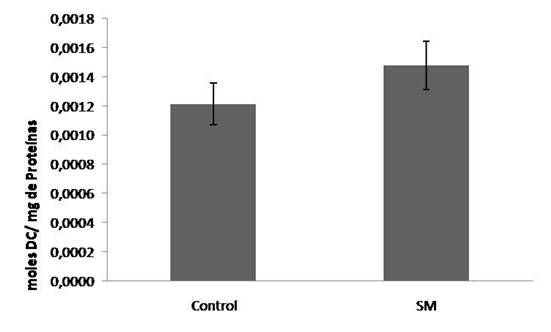Levels of malondialdehy and conjugated dienes in liver of rats with experimental metabolic syndrome
Keywords:
Metabolic syndrome, MDA, conjugated dienes, liverAbstract
Metabolic syndrome (MS) is a cluster of metabolic abnormalities, which presents with hepatosteatosis associated with hepatic oxidative stress. In this study, hepatic level of conjugated dienes (DC) and malondialdehyde (MDA) in experimental SM were determinated. Adult male Sprague Dawley rats were used and induction of SM was performed with 10% fructose in drinking water for 15 days, at the end of this time Fasting blood sample was obtained to determine blood chemistries (glucose, triglycerides and cholesterol) by commercial kits and insulin by competitive ELISA. Liver samples were homogenized to quantify levels of DC (isopropanol extraction) and MDA (TBARS). The SM group showed elevated levels of glucose, triglycerides, cholesterol and insulin significantly (p≤0,05) relative to the control group. As regard the levels of liver DC a slight increase in the group with MS (0.0014 ± 0.00016 mol / mg PT) when compared with the control group (0.0012 ± 0.00014 mol / PT mg) was observed without reaching significant difference, meanwhile MDA levels of the control group (1.8 ± 0.15 nmol / mg PT) has higher levels than the animals with SM (1.5 ± 0.08 nmol / mg PT) no significant differences (p≤0,05). Conclusion: Fructose was effective to induce SM. The levels of DC and MDA are not high, which could be related to the ability of cells to activate antioxidant mechanisms (Mn-SOD and NADPH) in presence of free radicals within 15 days of SM induction.
Downloads
References
[2] López ME, Sosa MA, Paulo N, Labrousse M. Síndrome metabólico. Rev PosgradoVI Cátedra Med 2007; 174:12-15.
[3] Ayala De La Peña I, Cámara P, Fernández Pardo J, Flores I, Cascales AI, Gutiérrez Panizo C, Valdés M, Castells Mora MT, García Pérez B. Modelos animales experimentales de enfermedad de hígado graso y síndrome metabólico. Anal Vet (Murcia) 2008; 24:5-16.
[4] Angelova P, Boyadjiev N. A review on the models of obesity and metabolic syndrome in rats. Trakia J Sci 2013; 1:5-12.
[5] Lizarzaburu JC. Síndrome metabólico: concepto y aplicación práctica. Anales Fac Med, USM 2013; 74(4):315-320.
[6] Cordero A, Alegría E, León M. Prevalencia de síndrome metabólico. Rev Esp Cardiol Supl 2005; 5(D):11-15.
[7] Ferretti SE, Tanno ME, Vorobioff JD. Hígado graso, resistencia insulínica y sindrome metabólico. Anuario Fundación Dr. J. R. Villavicencio 2004; XII: 084-086.
[8] Mendoza C, Márquez YC, Matheus N, Aranguren A, El Abed Y, López-Ortega AA. Correlación entre la concentracion de glucosa, hígado graso y estrés oxidativo hepático en Diábetes Mellitus. Gaceta Cs Vet 2010; 15(2):58-63.
[9] López-Ortega AA, Aranguren AJ, Plaza MA, Murillo M.D. Estrés oxidativo y alteraciones de la funcionalidad hepática en ratones hembras con hígado graso experimental. Rev vet 2014; 25(1):7-11
[10] Roglans N, Vilá L, Farré M, Alegret M, Sánchez RM, Vazquez-Carrera M and Laguna JC. Impairment of hepatic Stat-3 activation and reduction of PPAR activity in fructose-fed rats. Hepatology 2007; 45(3):778-788.
[11] Wallin B, Rosengren, B, Shertzer H, Camejo G. Lipoprotein oxidation and measurement of thiobarbituric acid reacting substances formation in a single microtiter plate: its use for evaluation of antioxidants. Anal Biochem. 1993; 208:10-15.
[12] Ohkawa H, Ohishi N, Yagi, K. Assay for lipid peroxides in animal tissues by thiobarbituric acid reaction. Anal Biochem 1979; 95:351-358.
[13] Bradford M.A. A rapid and sensitive method for the quantities of microgram of protein utilizing the principle of protein-dye binding. Anal Biochem. 1976; 72:248-254.
[14] Johnson RJ, Segal MS, Sautin Y, Nakagawa T, Feig DI, Kang DH, Gersch MS, Benner S, Sánchez-Lozada LG. Potential role of sugar (fructose) in the epidemic of hypertension, obesity and the metabolic syndrome, diabetes, kidney disease, and cardiovascular disease. Am J Clin Nutr. 2007; 86:899-906.
[15] Roberts CK, Sindhu KK. Oxidative stress and metabolic syndrome. Life Sci. 2009; 84:705-712.
[16] Vincent HK, Taylor AG. Biomarkers and potential mechanisms of obesity-induced oxidant stress in humans. Int J Obes 2006; 30:400-418.
[17] Erol A. Insulin resistance is an evolutionarily conserved physiological mechanism at the cellular level for protection against increased oxidative stress. Bioessays 2007; 29(8):811-818.
[18] Bloch-Damti A, Bashan N. Proposed mechanisms for the induction of insulin resistance by oxidative stress. Antioxid Redox Signal. 2005; 7(11-12):1553-1567.
[19] Dröge W. Free radicals in the physiological control of cell function. Physiol Rev 2002; 82(1):47-95.
[20] Evans JL, Maddux BA, Goldfine ID. The molecular basis for oxidative stress-induced insulin resistance. Antioxid Redox Signal 2005; 7(7-8):1040-1052.
[21] Buqué P, Ochoa B. Fundamento molecular de la esteatosis hepática asociada a la obesidad. X Rev Esp Enferm Dig. 2008; 100(9):565-578.
[22] Goodson G, Qiu Y, Sutton A, Xie G, Jia W, O’Brien A. Metabolic substrates exhibit differential effects on functional parameters of mouse sperm capacitation. Biol Reprod 2012; 87(3):1-15.

Published
How to Cite
Issue
Section
Gaceta de Ciencias Veterinarias se apega al modelo Open Access, por ello no se exige suscripción, registro o tarifa de acceso a los usuarios o instituciones. Los usuarios pueden leer, descargar, copiar, distribuir, imprimir y compartir los textos completos inmediatamente después de publicados, se exige no hacer uso comercial de las publicaciones. Para la reproducción parcial o total de los trabajos o contenidos publicados, se exige reconocer los derechos intelectuales de los autores y además, hacer referencia a esta revista. La publicación de artículos se hace sin cargo para los autores. Los trabajos pueden consultarse y descargarse libremente, y de manera gratuita, en extenso en versión digital, desde su enlace Web institucional. Los textos publicados son propiedad intelectual de sus autores. Las ideas, opiniones y conceptos expuestos en los trabajos publicados en la revista representan la opinión de sus autores, por lo tanto, son estos los responsables exclusivos de los mismos.


